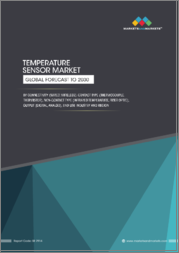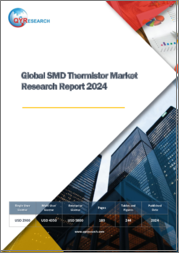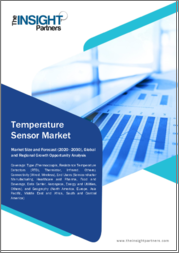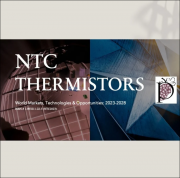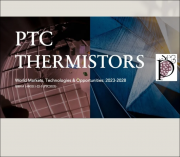
|
시장보고서
상품코드
1733611
세계의 PTC(Positive Temperature Coefficient) 서미스터 시장 규모 : 유형별, 용도별, 지역별, 예측Global Positive Temperature Coefficient (PTC) Thermistor Market Size By Type (Ceramic PTC, Polymer PTC), By Application (Consumer Electronics, Automotive, Industrial, Telecom), By Geographic Scope And Forecast |
||||||
PTC 서미스터 시장 규모 및 예측
PTC 서미스터 시장 규모는 2024년에 6억 329만 달러로 평가되었고, 2026-2032년 연평균 7.9%의 연평균 복합 성장률(CAGR)로 성장하여 2032년에는 11억 840만 달러에 달할 것으로 예측됩니다.
PTC(Positive Temperature Coefficient) 서미스터 세계 시장은 몇 가지 요인에 의해 주도되고 있습니다. 첫째, PTC 서미스터는 온도 감지, 과전류 보호, 회로 보호 등의 용도로 널리 사용되고 있으며, 가전제품, 자동차용 일렉트로닉스, 통신 장비 수요 증가가 시장 성장을 견인하고 있습니다. 둘째, 에너지 효율과 재생 가능 에너지에 대한 관심이 높아지면서 스마트 그리드 시스템 및 태양광 패널에서 PTC 서미스터에 대한 수요가 증가하고 있습니다.
PTC 서미스터 시장 정의
PTC(Positive Temperature Coefficient) 서미스터 시장은 양의 저항과 온도 관계를 나타내는 유형의 서미스터 시장을 의미하며, PTC 서미스터는 온도 상승에 따라 저항값이 크게 증가하는 감온 저항기입니다. 이 서미스터는 주로 온도 감지, 과전류 보호, 회로 보호 등 다양한 용도의 전자기기 및 시스템에 사용됩니다.
PTC 서미스터에서 저항의 거동은 일반적으로 세라믹 배합을 기반으로 한 특정 재료의 저항률의 양수 온도 계수에 의해 지배됩니다. 온도가 상승하면 PTC 서미스터의 내부 구조가 변화하여 저항 값이 급격히 상승합니다. 이 독특한 특성으로 인해 PTC 서미스터는 온도가 특정 임계값을 초과하면 전류의 흐름을 제한하는 자기 조절 장치 역할을 합니다. 이 특성으로 인해 과전류 및 과열로부터 회로 및 부품을 보호하는 데 유용합니다.
PTC 서미스터 시장 개요
스마트폰, 태블릿, 웨어러블 기기, 차량용 전자기기 등 전자기기의 보급으로 PTC 서미스터에 대한 수요가 증가하고 있습니다. 이러한 서미스터는 전자기기의 온도 감지 및 과전류 보호에 필수적입니다. 전 세계적으로 에너지 효율성과 지속 가능한 솔루션에 대한 관심이 높아지면서 PTC 서미스터에 대한 수요도 증가하고 있습니다. 이 서미스터는 스마트 그리드 시스템, 태양광 패널, 에너지 효율이 높은 가전제품에 사용되어 적절한 온도 제어와 전기적 장애로부터 보호합니다.
소형화, 응답 시간 개선, 정확도 향상 등 PTC 서미스터 기술의 지속적인 발전은 시장 성장의 원동력이 되고 있습니다. 이러한 발전으로 인해 더 작고 복잡한 전자기기에 통합할 수 있게 되었습니다. PTC 서미스터 시장은 경쟁이 치열하며, 여러 기존 업체와 신규 진입 업체가 존재합니다. 치열한 경쟁은 가격 압박과 수익률에 영향을 미칠 수 있습니다. 네거티브 온도 계수(NTC) 서미스터, 열전대, 반도체 소재 기반 온도 센서 등 대체 온도 감지 및 보호 기술이 PTC 서미스터의 성장에 도전하고 있습니다.
전기자동차의 보급 증가는 PTC 서미스터에 큰 비즈니스 기회를 가져다주고 있습니다. 이 서미스터는 EV의 배터리 관리, 모터 제어, 온도 모니터링에 사용되어 자동차 분야에서 큰 수요를 창출하고 있습니다. 산업 공정의 자동화와 인더스트리 4.0의 도입은 PTC 서미스터에 기회를 제공하고 있으며, PTC 서미스터는 산업 장비의 온도 모니터링 및 제어에 사용되어 최적의 성능을 보장하고 과열 및 손상을 방지하는 데 사용됩니다.
시장의 매력
세계 PTC 서미스터 시장을 주도하는 지역에 대한 정보를 얻으려면 시장 매력도를 파악하는 것이 도움이 될 것입니다. 이 보고서는 특정 지역의 산업 성장을 이끄는 주요 영향요인을 다루고 있습니다.
Portre's Five Forces
Porter의 Five Forces는 경쟁사의 행동과 각 산업에서의 전략적 포지셔닝을 이해하기 위한 청사진을 제공하는 프레임워크입니다. Portre's Five Forces 모델은 세계 PTC 서미스터 시장 경쟁 구도를 평가하고, 특정 분야의 매력을 측정하고, 투자 잠재력을 평가하는 데 사용할 수 있습니다.
목차
제1장 서론
- 시장 개요
- 조사 범위
- 전제조건
제2장 주요 요약
제3장 VERIFIED MARKET RESEARCH의 조사 방법
- 데이터 마이닝
- 밸리데이션
- 1차 자료
- 데이터 소스 리스트
제4장 시장 개요
- 개요
- 시장 역학
- 성장 촉진요인
- 성장 억제요인
- 기회
- Porter's Five Forces 모델
- 밸류체인 분석
- 규제 프레임워크
제5장 PTC 서미스터 시장 : 유형별
- 개요
- 세라믹 PTC
- 폴리머 PTC
제6장 PTC 서미스터 시장 : 용도별
- 개요
- 소비자 가전
- 자동차
- 산업
- 통신
- 의료
- 항공우주 및 방위
- 기타
제7장 PTC 서미스터 시장 : 지역별
- 개요
- 북미
- 미국
- 캐나다
- 멕시코
- 유럽
- 독일
- 영국
- 프랑스
- 기타 유럽
- 아시아태평양
- 중국
- 일본
- 인도
- 기타 아시아태평양
- 라틴아메리카
- 브라질
- 아르헨티나
- 세계 기타 지역
제8장 경쟁 구도
- 개요
- 기업별 시장 점유율
- 벤더 구도
- 주요 발전 전략
제9장 기업 개요
- Murata Manufacturing Co. Ltd.
- TDK Corporation
- Vishay Intertechnology Inc.
- Amphenol Corporation
- AVX Corporation
- Honeywell International Inc.
- TE Connectivity Ltd.
- KEMET Corporation
제10장 부록
- 관련 조사
Positive Temperature Coefficient (PTC) Thermistor Market Size And Forecast
Positive Temperature Coefficient (PTC) Thermistor Market size was valued at USD 603.29 Million in 2024 and is projected to reach USD 1108.4 Million by 2032, growing at a CAGR of 7.9% from 2026 to 2032.
The Global Positive Temperature Coefficient (PTC) Thermistor Market is driven by several factors. Firstly, the increasing demand for consumer electronics, automotive electronics, and telecommunications devices fuels market growth. PTC thermistors are widely used in these applications for temperature sensing, overcurrent protection, and circuit protection. Secondly, the growing emphasis on energy efficiency and renewable energy sources drives the demand for PTC thermistors in smart grid systems and solar panels.
Global Positive Temperature Coefficient (PTC) Thermistor Market Definition
The Global Positive Temperature Coefficient (PTC) Thermistor Market refers to the market for a type of thermistor that exhibits a positive resistance-temperature relationship. PTC thermistors are temperature-sensitive resistors whose resistance increases significantly with an increase in temperature. These thermistors are primarily used in electronic devices and systems for various applications, including temperature sensing, overcurrent protection, and circuit protection.
In PTC thermistors, the resistance behavior is governed by the positive temperature coefficient of resistivity of certain materials, commonly based on ceramic formulations. As the temperature rises, the internal structure of the PTC thermistor undergoes a change, causing an abrupt increase in resistance. This unique characteristic allows PTC thermistors to act as self-regulating devices, limiting the flow of current when the temperature exceeds a certain threshold. This feature makes them valuable for protecting circuits and components from excessive current and overheating.
Global Positive Temperature Coefficient (PTC) Thermistor Market Overview
The proliferation of electronic devices, including smartphones, tablets, wearable devices, and automotive electronics, drives the demand for PTC thermistors. These thermistors are crucial for temperature sensing and overcurrent protection in these devices. The global focus on energy efficiency and the need for sustainable solutions propel the demand for PTC thermistors. These thermistors are used in smart grid systems, solar panels, and energy-efficient appliances to ensure proper temperature control and protection against electrical faults.
Ongoing advancements in PTC thermistor technology, such as miniaturization, improved response time, and enhanced accuracy, drive market growth. These advancements enable their integration into smaller and more complex electronic devices. The Positive Temperature Coefficient (PTC) Thermistor Market is highly competitive, with several established players and new entrants. Intense competition can lead to pricing pressures and profit margins being affected. Alternative temperature sensing and protection technologies, such as Negative Temperature Coefficient (NTC) thermistors, thermocouples, and temperature sensors based on semiconductor materials, pose a challenge to the growth of PTC thermistors.
The rising adoption of electric vehicles presents significant opportunities for PTC thermistors. These thermistors are used for battery management, motor control, and temperature monitoring in EVs, creating a substantial demand in the automotive sector. The automation of industrial processes and the implementation of Industry 4.0 principles create opportunities for PTC thermistors. They are utilized for temperature monitoring and control in industrial equipment, ensuring optimal performance and preventing overheating or damage.
Market Attractiveness
The image of market attractiveness provided would further help to get information about the region that is majorly leading in the Global Positive Temperature Coefficient (PTC) Thermistor Market. We cover the major impacting factors that are responsible for driving the industry growth in the given region.
Porter's Five Forces
The image provided would further help to get information about Porter's five forces framework providing a blueprint for understanding the behavior of competitors and a player's strategic positioning in the respective industry. Porter's five forces model can be used to assess the competitive landscape in the Global Positive Temperature Coefficient (PTC) Thermistor Market, gauge the attractiveness of a certain sector, and assess investment possibilities.
Global Positive Temperature Coefficient (PTC) Thermistor Market Segmentation Analysis
The Global Positive Temperature Coefficient (PTC) Thermistor Market is Segmented on the basis of Type, Application, and Geography.
Positive Temperature Coefficient (PTC) Thermistor Market, By Type
- Ceramic PTC
- Polymer PTC
Based on Type, the market is segmented into Ceramic PTC and polymer PTC. Ceramic PTC thermistors are composed of ceramic materials and exhibit high stability, reliability, and accuracy in temperature sensing and circuit protection applications. On the other hand, polymer PTC thermistors are made of conductive polymers and offer advantages such as flexibility, lightweight, and easy integration into various electronic devices. Both types of PTC thermistors cater to different application requirements and contribute to the overall growth of the market.
Positive Temperature Coefficient (PTC) Thermistor Market, By Application
- Consumer Electronics
- Automotive
- Industrial
- Telecom
- Medical
- Aerospace & Defense
Based on Application, the market is segmented into Consumer Electronics, Automotive, Industrial, Telecom, Medical, and Aerospace & Defense. The Positive Temperature Coefficient (PTC) Thermistor Market finds application across various industries. It is widely utilized in consumer electronics, automotive electronics, industrial equipment, telecommunications devices, medical devices, and aerospace & defense systems. PTC thermistors play a crucial role in temperature sensing, overcurrent protection, and circuit protection in these applications, ensuring safe and efficient operation.
Positive Temperature Coefficient (PTC) Thermistor Market, By Geography
- North America
- Europe
- Asia Pacific
- Latin America
- Middle East Asia
Based on Regional Analysis, the Global Positive Temperature Coefficient (PTC) Thermistor Market is classified into North America, Europe, Asia Pacific, and the Rest of the world. The Positive Temperature Coefficient (PTC) Thermistor Market is geographically diverse, with its demand and distribution varying across different regions. North America holds a significant share, driven by the presence of major industries and technological advancements. Europe is another prominent market due to the strong emphasis on energy efficiency and stringent regulations.
Key Players
The "Global Positive Temperature Coefficient (PTC) Thermistor Market" study report will provide valuable insight with an emphasis on the global market including some of the major players such as Murata Manufacturing Co., Ltd., TDK Corporation, Vishay Intertechnology, Inc., Amphenol Corporation, AVX Corporation, Honeywell International Inc., TE Connectivity Ltd., KEMET Corporation.
Our market analysis includes a section specifically devoted to such major players, where our analysts give an overview of each player's financial statements, along with product benchmarking and SWOT analysis. Key development strategies, market share analysis, and market positioning analysis of the aforementioned players globally are also included in the competitive landscape section.
Key Developments
- In Dec 2021, Honeywell is set to acquire US Digital Designs, Inc., in a move that will enhance their capabilities in public safety communications. This acquisition will allow Honeywell to expand its offerings in the field of public safety and further strengthen its position in providing communication solutions for critical situations and emergency response.
- Ace Matrix Analysis
- The Ace Matrix provided in the report would help to understand how the major key players involved in this industry are performing as we provide a ranking for these companies based on various factors such as service features & innovations, scalability, innovation of services, industry coverage, industry reach, and growth roadmap. Based on these factors, we rank the companies into four categories as Active, Cutting Edge, Emerging, and Innovators.
TABLE OF CONTENTS
1 INTRODUCTION OF GLOBAL POSITIVE TEMPERATURE COEFFICIENT (PTC) THERMISTOR MARKET
- 1.1 Overview of the Market
- 1.2 Scope of Report
- 1.3 Assumptions
2 EXECUTIVE SUMMARY
3 RESEARCH METHODOLOGY OF VERIFIED MARKET RESEARCH
- 3.1 Data Mining
- 3.2 Validation
- 3.3 Primary Interviews
- 3.4 List of Data Sources
4 GLOBAL POSITIVE TEMPERATURE COEFFICIENT (PTC) THERMISTOR MARKET OUTLOOK
- 4.1 Overview
- 4.2 Market Dynamics
- 4.2.1 Drivers
- 4.2.2 Restraints
- 4.2.3 Opportunities
- 4.3 Porters Five Force Model
- 4.4 Value Chain Analysis
- 4.5 Regulatory Framework
5 GLOBAL POSITIVE TEMPERATURE COEFFICIENT (PTC) THERMISTOR MARKET, BY TYPE
- 5.1 Overview
- 5.2 Ceramic PTC
- 5.3 Polymer PTC
6 GLOBAL POSITIVE TEMPERATURE COEFFICIENT (PTC) THERMISTOR MARKET, BY APPLICAITON
- 6.1 Overview
- 6.2 Consumer Electronics
- 6.3 Automotive
- 6.4 Industrial
- 6.5 Telecom
- 6.6 Medical
- 6.7 Aerospace & Defense
- 6.8 Others
7 GLOBAL POSITIVE TEMPERATURE COEFFICIENT (PTC) THERMISTOR MARKET, BY GEOGRAPHY
- 7.1 Overview
- 7.2 North America
- 7.2.1 U.S.
- 7.2.2 Canada
- 7.2.3 Mexico
- 7.3 Europe
- 7.3.1 Germany
- 7.3.2 U.K.
- 7.3.3 France
- 7.3.4 Rest of Europe
- 7.4 Asia Pacific
- 7.4.1 China
- 7.4.2 Japan
- 7.4.3 India
- 7.4.4 Rest of Asia Pacific
- 7.5 Latin America
- 7.5.1 Brazil
- 7.5.2 Argentina
- 7.6 Rest of the World
8 GLOBAL POSITIVE TEMPERATURE COEFFICIENT (PTC) THERMISTOR MARKET COMPETITIVE LANDSCAPE
- 8.1 Overview
- 8.2 Company Market Share
- 8.3 Vendor Landscape
- 8.4 Key Development Strategies
9 COMPANY PROFILES
- 9.1 Murata Manufacturing Co. Ltd.
- 9.1.1 Overview
- 9.1.2 Financial Performance
- 9.1.3 Product Outlook
- 9.1.4 Key Developments
- 9.2 TDK Corporation
- 9.2.1 Overview
- 9.2.2 Financial Performance
- 9.2.3 Product Outlook
- 9.2.4 Key Developments
- 9.3 Vishay Intertechnology Inc.
- 9.3.1 Overview
- 9.3.2 Financial Performance
- 9.3.3 Product Outlook
- 9.3.4 Key Developments
- 9.4 Amphenol Corporation
- 9.4.1 Overview
- 9.4.2 Financial Performance
- 9.4.3 Product Outlook
- 9.4.4 Key Developments
- 9.5 AVX Corporation
- 9.5.1 Overview
- 9.5.2 Financial Performance
- 9.5.3 Product Outlook
- 9.5.4 Key Developments
- 9.6 Honeywell International Inc.
- 9.6.1 Overview
- 9.6.2 Financial Performance
- 9.6.3 Product Outlook
- 9.6.4 Key Developments
- 9.7 TE Connectivity Ltd.
- 9.7.1 Overview
- 9.7.2 Financial Performance
- 9.7.3 Product Outlook
- 9.7.4 Key Developments
- 9.8 KEMET Corporation
- 9.8.1 Overview
- 9.8.2 Financial Performance
- 9.8.3 Product Outlook
- 9.8.4 Key Developments
10 Appendix
- 10.1 Related Research








